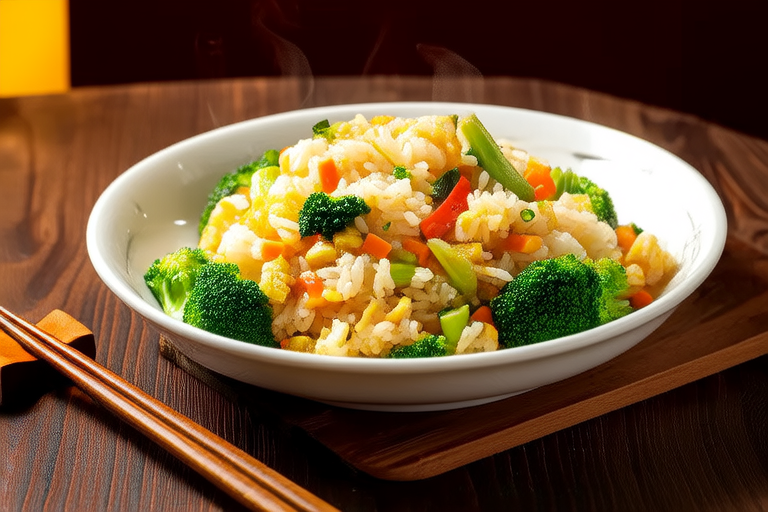- Introduction to Vegetable Stir-Fry over Rice
Vegetable stir-fry over rice is a versatile and nutritious dish that can be customized with an array of vegetables, making it both delicious and healthy. This dish is perfect for those looking for a quick and easy meal, as well as for those who want to experiment with different flavors and textures. In this recipe, we will explore the steps involved in preparing a delectable vegetable stir-fry over rice, highlighting the importance of selecting fresh ingredients and using proper cooking techniques.
The beauty of this dish lies in its simplicity. With just a few key ingredients, you can create a meal that is not only satisfying but also packed with nutrients. The combination of tender vegetables and fluffy rice creates a harmonious balance of flavors and textures that will leave your taste buds craving more. Additionally, this dish is incredibly adaptable, allowing you to tailor it to your personal preferences or dietary restrictions.
In the following sections, we will delve into the specifics of preparing this dish, including the selection of vegetables, the preparation of the rice, and the cooking process itself. We will also discuss the importance of seasoning and how to achieve the perfect balance of flavors. By the end of this guide, you will have all the knowledge you need to prepare a mouthwatering vegetable stir-fry over rice that is sure to become a favorite in your kitchen.
- Selecting Fresh Ingredients
The foundation of any great dish is the quality of its ingredients. When preparing a vegetable stir-fry over rice, it is crucial to select fresh, high-quality vegetables that will add both flavor and texture to the dish. Here are some tips for choosing the best vegetables:
- Choose a Variety of Vegetables: A good stir-fry should include a mix of vegetables that offer different colors, textures, and flavors. Some popular choices include bell peppers, broccoli, carrots, snap peas, and mushrooms. Each vegetable adds its own unique touch, contributing to the overall complexity of the dish.
- Look for Freshness: When selecting vegetables, make sure they are firm, vibrant, and free from blemishes. Fresh vegetables will cook evenly and retain their bright colors, enhancing the visual appeal of the dish. For example, crisp bell peppers and vibrant green beans will add a pop of color and freshness to the stir-fry.
- Consider Seasonal Availability: Using seasonal vegetables not only ensures that you are getting the freshest produce but also supports local farmers. Seasonal vegetables tend to be more flavorful and nutrient-dense. For instance, during the summer months, you might choose zucchini and cherry tomatoes, while in the fall, you could opt for Brussels sprouts and butternut squash.
- Prepare Vegetables Properly: Once you have selected your vegetables, it’s important to prepare them correctly. This may involve washing, trimming, and slicing them into uniform pieces so that they cook evenly. For example, slice the bell peppers into thin strips, cut the broccoli into florets, and julienne the carrots. Proper preparation ensures that each vegetable cooks to perfection without becoming soggy or undercooked.
By carefully selecting and preparing your vegetables, you set the stage for a delicious and visually appealing vegetable stir-fry over rice. The right choice of ingredients is the first step toward creating a meal that is both satisfying and nourishing.
- Preparing the Rice
The base of any rice dish is, of course, the rice itself. While white rice is the most commonly used variety, there are many other types of rice that can elevate the dish and add depth to the flavors. In this section, we will explore the different types of rice available and provide detailed instructions on how to prepare the perfect batch of rice for your vegetable stir-fry.
- Choosing the Right Type of Rice: There are numerous types of rice, each with its own distinct characteristics. For a vegetable stir-fry, long-grain white rice is often preferred due to its light and fluffy texture. However, if you’re looking for a nuttier flavor and more robust texture, consider using brown rice or jasmine rice. Wild rice, while not technically a rice, can also be incorporated for added texture and nutrition. Each type of rice brings something unique to the table, so feel free to experiment with different varieties to find your favorite.
- Measuring and Washing the Rice: Proper measurement and washing are essential for achieving the ideal texture and consistency of the rice. Generally, use a ratio of 1 part rice to 2 parts water. For example, if you’re using 1 cup of rice, you’ll need 2 cups of water. It’s also a good idea to rinse the rice before cooking to remove excess starch and prevent clumping. To do this, place the rice in a fine-mesh strainer and run cold water over it until the water runs clear. Rinsing helps ensure that the rice cooks evenly and doesn’t become mushy.
- Cooking the Rice: There are several methods for cooking rice, each yielding slightly different results. One of the most common methods is the stovetop method. Start by bringing the measured water to a boil in a medium saucepan. Once the water is boiling, gently add the rinsed rice and reduce the heat to low. Cover the pot and let it simmer for about 18-20 minutes, or until the rice is tender and has absorbed most of the water. If using a rice cooker, simply add the measured rice and water to the cooker and press the “cook” button. The rice cooker will automatically adjust the cooking time and temperature for optimal results. Another option is the microwave method, which involves placing the rice and water in a microwave-safe bowl, covering it with a microwave-safe lid or plastic wrap, and microwaving on high for 5-7 minutes, followed by a 5-minute rest period. Regardless of the method, it’s important to allow the rice to rest for a few minutes after cooking to let the grains absorb any remaining moisture and settle into a fluffy texture.
- Fluffing the Rice: Once the rice is cooked, fluff it with a fork to separate the grains and release any steam. This step is crucial for achieving that light, airy texture that makes the rice perfect for pairing with the stir-fried vegetables. Fluffing also helps to eliminate any potential clumping, ensuring that each grain remains distinct and flavorful. After fluffing, the rice should be ready to serve alongside the stir-fried vegetables.
By carefully selecting the right type of rice and following these precise cooking techniques, you can prepare a perfectly cooked batch of rice that will complement your vegetable stir-fry beautifully. The fluffy texture and subtle flavor of the rice provide a perfect backdrop for the vibrant and savory vegetables, creating a harmonious and satisfying dish.
- Cooking Techniques for the Vegetable Stir-Fry
The success of a vegetable stir-fry lies in the cooking techniques used to bring out the best flavors and textures of each ingredient. Proper cooking methods ensure that the vegetables remain crisp and vibrant, while the sauce is rich and flavorful. In this section, we will explore the essential techniques for preparing a delicious vegetable stir-fry, from heating the wok to seasoning the dish.
- Heating the Wok: A hot wok is essential for achieving the desired sear on the vegetables and ensuring even cooking. Begin by preheating your wok over high heat until it is very hot. You can test the readiness of the wok by adding a few drops of water; if they sizzle and evaporate quickly, the wok is ready. Once heated, add a small amount of oil, such as peanut or sesame oil, which has a high smoke point and can withstand high temperatures. Swirl the oil around the wok to coat the surface evenly. This step not only prevents sticking but also imparts a subtle flavor to the dish.
- Stir-Frying in Stages: To maintain the crispness and vibrant colors of the vegetables, it’s important to stir-fry them in stages based on their cooking times. Start with harder vegetables like carrots, snap peas, and broccoli, as they require more time to cook. Add these to the hot wok and stir-fry for 2-3 minutes, or until they are just tender but still crisp. Next, add softer vegetables like bell peppers and mushrooms, which cook more quickly. Continue stirring and tossing the vegetables to ensure even cooking and prevent burning. Finally, add any delicate vegetables, such as snow peas or baby spinach, which should be added at the very end and only cooked for 30 seconds to 1 minute. This staged approach allows each vegetable to cook to perfection, maintaining its texture and flavor.
- Seasoning the Dish: Proper seasoning is key to balancing the flavors in your vegetable stir-fry. Begin by adding a small amount of salt and pepper to taste. Then, incorporate additional seasonings such as soy sauce, garlic, ginger, and chili flakes to enhance the flavor profile. Soy sauce provides a savory umami flavor, while garlic and ginger add warmth and depth. Chili flakes, if desired, can introduce a hint of spiciness. Be mindful of the amount of seasoning you add, as too much can overpower the natural flavors of the vegetables. It’s always better to start with less and adjust as needed. Taste the stir-fry as you go and make any necessary adjustments to achieve the desired level of seasoning.
- Adding Sauce and Garnishes: Once the vegetables are cooked to your liking, it’s time to add the sauce. A simple sauce can be made by combining soy sauce, oyster sauce, and a bit of water or broth. Pour the sauce over the vegetables and stir to coat evenly. Let the sauce simmer for a minute or two to allow the flavors to meld together. Just before serving, garnish the stir-fry with fresh herbs like cilantro or green onions, as well as a sprinkle of sesame seeds for added texture and flavor. These finishing touches elevate the dish, adding a burst of freshness and visual appeal.
By mastering these cooking techniques, you can create a vegetable stir-fry that is not only visually appealing but also bursting with flavor. The combination of perfectly cooked vegetables, a well-balanced sauce, and thoughtful garnishes will result in a dish that is both satisfying and enjoyable.
- Serving Suggestions and Pairings
A well-prepared vegetable stir-fry over rice is a meal in itself, but there are many ways to enhance and complement this dish. In this section, we will explore various serving suggestions and pairing options that can elevate your vegetable stir-fry to new heights.
- Protein Options: While the focus of this dish is on the vegetables, adding a protein source can further enrich the meal. Consider incorporating tofu, tempeh, or chicken. Tofu, when stir-fried with the vegetables, absorbs the flavors of the sauce and adds a satisfying texture. Tempeh, made from fermented soybeans, offers a nutty flavor and a firmer bite. Grilled or sautéed chicken breast can provide a protein boost and add a mild, savory element to the dish. Simply slice the protein of your choice into bite-sized pieces and stir-fry it along with the vegetables for a complete and balanced meal.
- Additional Accompaniments: To add variety and depth to your vegetable stir-fry, consider serving it with complementary side dishes. Steamed bok choy or a side salad can provide a refreshing contrast to the warm, hearty stir-fry. A bowl of miso soup can cleanse the palate between bites and add a comforting element to the meal. Additionally, a drizzle of toasted sesame oil over the finished dish can enhance the nutty flavor and add a touch of richness. These accompaniments not only enhance the overall dining experience but also provide a well-rounded nutritional profile.
- Dipping Sauces and Condiments: Adding dipping sauces or condiments can further personalize the dish and cater to individual tastes. A classic choice is a mixture of soy sauce, rice vinegar, and a touch of sugar, which provides a tangy and sweet contrast to the savory stir-fry. Sriracha or chili garlic sauce can be offered for those who enjoy a bit of heat. A dollop of hoisin sauce adds a thick, sweet, and slightly spicy flavor that pairs well with the vegetables. These condiments allow diners to customize their servings according to their preferences, making the dish more interactive and enjoyable.
- Pairing with Beverages: Selecting the right beverage to accompany your vegetable stir-fry can enhance the overall dining experience. For a light and refreshing option, consider pairing the dish with a crisp white wine, such as a Pinot Grigio or Sauvignon Blanc. These wines have a clean, citrusy flavor that complements the vegetable-based dish. Alternatively, a light beer, such as a pilsner or lager, can provide a refreshing contrast to the rich flavors of the stir-fry. Herbal teas, particularly green tea or jasmine tea, can also be a delightful accompaniment, offering a soothing finish to the meal. Ultimately, the choice of beverage should reflect your personal preference and the occasion.
By exploring these serving suggestions and pairings, you can elevate your vegetable stir-fry over rice into a truly memorable dining experience. Whether you’re looking to add protein, enhance the dish with side accompaniments, or choose the perfect beverage, there are countless ways to make this dish your own and satisfy your culinary desires.
- Conclusion
In conclusion, vegetable stir-fry over rice is a versatile and nutritious dish that can be tailored to suit a wide range of tastes and dietary preferences. By selecting fresh, high-quality vegetables and using proper cooking techniques, you can create a meal that is not only delicious but also visually appealing. The combination of tender vegetables and fluffy rice provides a harmonious balance of flavors and textures, making this dish a favorite in many kitchens.
This recipe has provided a comprehensive guide to preparing a delectable vegetable stir-fry over rice, from selecting the right ingredients to mastering the cooking techniques. Whether you’re a seasoned chef or a beginner in the kitchen, these steps will help you achieve a dish that is both satisfying and nourishing. Additionally, the suggested serving suggestions and pairings offer endless possibilities for customization, allowing you to make the dish your own.
So, the next time you’re in the mood for a quick, healthy, and flavorful meal, consider preparing a vegetable stir-fry over rice. With its simplicity and adaptability, this dish is sure to become a staple in your repertoire. Enjoy the process of cooking and savor every bite of this delightful creation.


